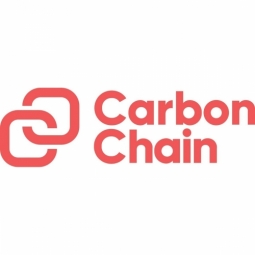CarbonChain

Overview
|
HQ Location
United Kingdom
|
Year Founded
2019
|
Company Type
Private
|
Revenue
$10-100m
|
|
Employees
11 - 50
|
Website
|
Twitter Handle
|
Company Description
CarbonChain is a CDP accredited solutions provider, a TCFD supporter, and ResponsibleSteel member. Its carbon accounting methodology is independently verified by Bureau Veritas and validated by SGS.
CarbonChain's platform enables companies to track, report and reduce their supply chain emissions, covering the most carbon-intensive industries (metals and mining, agriculture, and manufacturing).
IoT Snapshot
CarbonChain is a provider of Industrial IoT analytics and modeling, cybersecurity and privacy, platform as a service (paas), sensors, and application infrastructure and middleware technologies, and also active in the finance and insurance, metals, oil and gas, retail, and transportation industries.
Technologies
Use Cases
Functional Areas
Industries
Services
Technology Stack
CarbonChain’s Technology Stack maps CarbonChain’s participation in the analytics and modeling, cybersecurity and privacy, platform as a service (paas), sensors, and application infrastructure and middleware IoT Technology stack.
-
Devices Layer
-
Edge Layer
-
Cloud Layer
-
Application Layer
-
Supporting Technologies
Technological Capability:
None
Minor
Moderate
Strong

Supplier missing?
Start adding your own!
Register with your work email and create a new supplier profile for your business.
Case Studies.
Case Study
Mocoh's Transition to Lower Carbon Emissions with CarbonChain
Mocoh, a Geneva-based company supplying essential energy and resources across Africa, was facing a significant challenge in managing its greenhouse gas (GHG) emissions. In 2021, the company had little to no visibility of the carbon footprint or intensity of its oil and oil product trades. Mocoh wanted to lead the way in identifying sources of carbon emissions across its supply chain and publishing its findings. The company recognized the importance of transparent information and collaboration with all stakeholders in the complex energy transition. However, to do this, Mocoh needed to start measuring emissions from across its supply chain. The goals were to inform regulators with data-led information, understand the scale and structure of emissions in its products and transaction logistics, identify opportunities to reduce carbon intensity, and proactively and transparently share data with stakeholders.
Case Study
Rabobank's Journey Towards Transparent, Low-Carbon Supply Chains
Rabobank, a cooperative bank with a significant international banking operation, is committed to addressing its financed emissions and carbon risks. Since 2020, the bank has been working with clients to address high-emitting supply chains in its commodity trade finance portfolio. For instance, Rabobank implemented a pilot scheme offering metal commodity traders incentives for meeting sustainability targets and a template for clients to develop a climate action plan to decarbonize their trade flows. However, Rabobank faced a significant challenge: the lack of high-quality emissions data for clients’ supply chains. The bank recognized that to strengthen its green finance schemes and set quantified targets with measurable progress, it needed to overcome this barrier. Rabobank aimed to achieve three key goals: setting emissions reduction targets, advising clients on carbon risk reduction, and reducing the carbon footprint of its trade commodity finance portfolio.
Case Study
Concord's Journey to Industry-Leading Carbon Insight for Trade Portfolio
In 2019, Concord, a leading global independent metals and minerals trader, aimed to pioneer Scope 3 carbon footprinting in the commodities sector. However, the company faced the daunting task of analyzing over 10,000 trades, identifying key upstream assets, and bridging the notorious data gap for extractive emissions. Concord's supply chain emissions were the most significant, especially in the carbon-intensive commodities industry. The company wanted to take a market-leading approach, defining best practice in carbon accounting for commodity trading. Concord needed to quantify its total Scope 3 CO2 output, benchmark its performance, break down the emissions sources, and compare trades, suppliers, and assets. The company required accurate, verifiable, and comprehensive emissions calculations that all stakeholders could trust, covering all of its approximately 10,000 annual trades and the end-to-end supply chain for each one. The in-house execution of this task seemed impossible due to the volume of manual data collection and analysis required and the shortage of reliable emissions data for the extraction, production, and transport of commodities.
Case Study
Fusina's Initiative to Provide Carbon Footprint Data for Aluminum Products
Niche Fusina Rolled Products (Fusina), an Italy-based aluminum rolling mill, faced the challenge of providing its customers with detailed carbon footprint information for its tailor-made coils, metal sheets, and plates. The company aimed to enable prospective buyers to make informed purchasing decisions based on the average product carbon footprint. Additionally, Fusina wanted to provide customers with a carbon footprint report attached to their invoices, which could be used in their own Scope 3 reporting and product lifecycle calculations. The challenge was to roll out this scheme immediately, starting with marine and road transportation products delivered into Germany, Italy, Benelux, and Scandinavian markets, with the expectation to expand it across all Fusina’s products and countries by early 2023.
Case Study
CarbonChain's Solution for Gunvor's Carbon Disclosure Challenge
Gunvor Group, one of the world's largest independent commodities trading houses, faced a significant challenge when a key customer requested greenhouse gas (GHG) emissions data for all their naphtha trades. This data was to cover the entire supply chain, from the extraction of crude oil and condensate to the delivery of naphtha at the customer gate. However, Gunvor had limited information about their supply chain emissions. They had some calculations for their own vessels, but lacked data for upstream oil and gas activities or for the processing of oil into naphtha, except for their own refineries. To meet the customer's request, Gunvor would have needed to gather raw data from various sources and access time-sensitive, asset-level GHG emissions information, which was difficult, expensive, or impossible to obtain. The data analysis, calculation, and reporting process was set to be a huge challenge, as well as a cost and time burden.
Case Study
Driving Carbon Reductions in Trade Finance: A Case Study on Societe Generale and Concord
Societe Generale, a leading European financial services group, was facing a challenge in understanding the carbon footprint of its commodity trade finance portfolio. The company needed granular, actionable data to analyze its trade loan portfolio’s emissions and comprehend the carbon footprint of complex individual supply chains it finances globally. The commodities financed, such as oil, gas, metals, and agricultural materials, are some of the most carbon-intensive products. Therefore, understanding the embedded emissions in these financed trades was a critical first step towards reducing them in line with Societe Generale’s sustainability goals. However, obtaining accurate, asset-level emissions data for extractive and agricultural commodity supply chains was complex. The company sought to support its clients, like Concord Resources Limited, in their journey towards carbon neutrality, but lacked the necessary data to do so effectively.
Case Study
How CarbonChain helped Gunvor meet customer demand for carbon disclosure
Gunvor, a global leader in naphtha trading, faced a significant challenge when a key customer requested comprehensive greenhouse gas (GHG) emissions data for all their naphtha trades. This request covered the entire supply chain, from the extraction of crude oil and condensate to the delivery of naphtha at the customer's gate. Gunvor had limited information about their supply chain emissions, with some calculations for their own vessels but lacking data for upstream oil and gas activities and the processing of oil into naphtha, except for their own refineries. To calculate the entire supply chain carbon footprint for every trade, Gunvor needed to gather raw data from various sources and access time-sensitive, asset-level GHG emissions information, which was difficult, expensive, or impossible to obtain. This process, along with the subsequent data analysis, calculation, and reporting, posed a huge challenge, as well as a cost and time burden.
Case Study
How Mocoh uses CarbonChain to prepare for the energy transition
Mocoh faced the challenge of identifying and managing carbon emissions across its supply chain. The company recognized the importance of transparency and collaboration with stakeholders to progress in the energy transition. Mocoh needed to measure emissions to inform regulators, understand emissions scale and structure, identify reduction opportunities, and share data transparently. The company began using CarbonChain in 2021 to address these challenges.
Case Study
Concord's Journey to Industry-Leading Carbon Insight for Trade Portfolio with CarbonChain
In 2019, Concord faced the challenge of calculating Scope 3 emissions for its 10,000 annual trades. As a leading commodity merchant in the non-ferrous metals sector, Concord recognized the importance of understanding its carbon footprint to future-proof its business and manage carbon risk. The company aimed to take a market-leading approach in carbon accounting for commodity trading, which required accurate, verifiable, and comprehensive emissions calculations. Concord needed to benchmark its performance, break down emissions sources, and compare trades, suppliers, and assets to gain actionable insights for its carbon strategy. However, the task was daunting due to the sheer volume of manual data collection and analysis required, coupled with the notorious shortage of reliable emissions data for the extraction, production, and transport of commodities. Concord needed a cost-effective solution that could address these specific challenges, leading them to partner with CarbonChain.
Case Study
How Rabobank is working with commodity traders to build transparent supply chains for a net-zero future
Rabobank is committed to addressing the climate challenge by taking action on its financed emissions and carbon risks. Since 2020, the bank has been working with clients to tackle high-emitting supply chains in its commodity trade finance portfolio. A significant challenge was the lack of high-quality emissions data for clients’ supply chains, which hindered the ability to set quantified targets and measure progress. Rabobank recognized that collaboration with traders and the use of CarbonChain’s carbon accounting software could accelerate action towards setting emissions reduction targets, advising clients on carbon risk reduction, and reducing the carbon footprint of its trade commodity finance portfolio.







